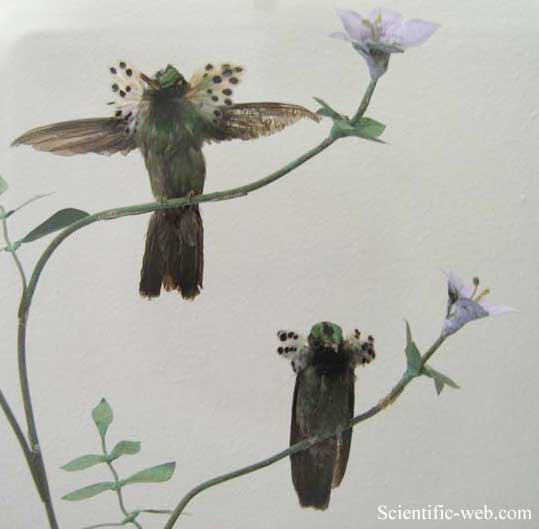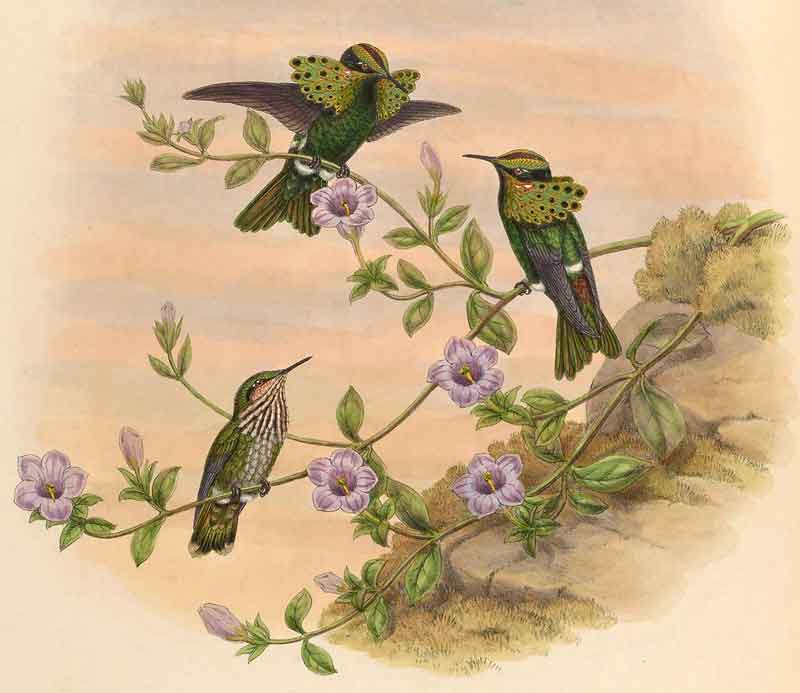
Lophornis pavoninus, Photo: Michael Lahanas
Superregnum: Eukaryota
Cladus: Unikonta
Cladus: Opisthokonta
Cladus: Holozoa
Regnum: Animalia
Subregnum: Eumetazoa
Cladus: Bilateria
Cladus: Nephrozoa
Superphylum: Deuterostomia
Phylum: Chordata
Subphylum: Vertebrata
Infraphylum: Gnathostomata
Megaclassis: Osteichthyes
Cladus: Sarcopterygii
Cladus: Rhipidistia
Cladus: Tetrapodomorpha
Cladus: Eotetrapodiformes
Cladus: Elpistostegalia
Superclassis: Tetrapoda
Cladus: Reptiliomorpha
Cladus: Amniota
Classis: Reptilia
Cladus: Eureptilia
Cladus: Romeriida
Subclassis: Diapsida
Cladus: Sauria
Infraclassis: Archosauromorpha
Cladus: Crurotarsi
Divisio: Archosauria
Cladus: Avemetatarsalia
Cladus: Ornithodira
Subtaxon: Dinosauromorpha
Cladus: Dinosauriformes
Cladus: Dracohors
Cladus: Dinosauria
Ordo: Saurischia
Cladus: Eusaurischia
Subordo: Theropoda
Cladus: Neotheropoda
Cladus: Averostra
Cladus: Tetanurae
Cladus: Avetheropoda
Cladus: Coelurosauria
Cladus: Tyrannoraptora
Cladus: Maniraptoromorpha
Cladus: Maniraptoriformes
Cladus: Maniraptora
Cladus: Pennaraptora
Cladus: Paraves
Cladus: Eumaniraptora
Cladus: Avialae
Infraclassis: Aves
Cladus: Euavialae
Cladus: Avebrevicauda
Cladus: Pygostylia
Cladus: Ornithothoraces
Cladus: Ornithuromorpha
Cladus: Carinatae
Parvclassis: Neornithes
Cohors: Neognathae
Cladus: Neoaves
Superordo: Caprimulgimorphae
Ordo: Apodiformes
Familia: Trochilidae
Subfamilia: Trochilinae
Genus: Lophornis
Species: Lophornis pavoninus
Subspecies: L. p. duidae – L. p. pavoninus
Synonyms: L. p. punctigula – included in nominal.
Name
Lophornis pavoninus Salvin & Godman, 1882
Type locality: Merume' Mountains, Guiana.
Synonyms
Lophornis pavonina (orth. err.)

References
Salvin, O. & Godman, F.D. 1882. VI. Notes on Birds from British Guiana. The Ibis 4(6): 76–84. BHL Reference page. p. 81 BHL
Vernacular names
English: Peacock Coquette
español: Coqueta pavonina
português: Topetinho-pavão
The peacock coquette (Lophornis pavoninus) is a species of hummingbird in the "coquettes", tribe Lesbiini of subfamily Lesbiinae. It is found in Brazil, Guyana, and Venezuela.[3][4]
Taxonomy and systematics
The peacock coquette and the festive coquette (Lophornis chalybeus) were for a time placed in genus Polemistria. (During that period and after, what is now the butterfly coquette (L. verreauxii) was treated as a subspecies of festive coquette.)[5][6] The peacock coquette has two subspecies, the nominate L. p. pavoninus and L. p. duidae.[3]
Description
The peacock coquette is about 9.7 cm (3.8 in) long. The male of the nominate subspecies has a glittering golden green head with a black line through its middle. Its upperparts are shiny dark green with a white band across the rump. The tail is purplish bronzy and slightly forked. It has long shiny green cheek tufts with large blackish blue spots at the ends and a rufous patch with a white dot near the eye. Its underparts are grayish green. The female does not have the cheek tufts. Its upperparts are golden bronzy with a buffy white band across the rump. Its tail is grayish; the feathers have a wide purplish bronzy band near the end and the outermost pair have white tips. The throat is white with black streaks and the rest of the underparts are mottled black, white, and green. Subspecies L. p. duidae is similar to the nominate but its black crown line and the rufous patch on the cheek are smaller.[6]
Distribution and habitat
The nominate subspecies of peacock coquette is found on Cerro Ptari-tepui and in Sierra de Lema in southeastern Venezuela's Bolívar state; on Mount Roraima where Venezuela, Brazil, and Guyana meet; and in the Merumé Mountains of Guyana. Subspecies L. p. duidae is found on Cerro Duida and nearby smaller tepuis in southeastern Venezuela's Amazonas state. The species inhabits the interior, clearings, and edges of rainforest and cloud forest at elevations between 500 and 2,000 m (1,600 and 6,600 ft).[6]
Behavior
Movement
The peacock coquette is thought to be mainly sedentary but appears to make migratory or nomadic movements in Sierra de Lema.[6]
Feeding
The peacock coquette forages for nectar in the forest canopy, usually alone but sometimes in small groups. Its diet also includes small arthropods that it apparently gleans from foliage.[6]
Breeding
The peacock coquette's nesting season is unknown. The female builds a cup nest suspended from a horizontal branch about 2 m (7 ft) above the ground. The clutch size is two; incubation lasts 13 to 14 days and fledging occurs about 20 days after hatch.[6]
Vocalization
The peacock coquette's vocalizations have not been described, and as of February 2022 no recordings are available at Xeno-canto or Cornell University's Macaulay Library.[6]
Status
The IUCN has assessed the peacock coquette as being of Least Concern, though its population size and trend are not known.[1] Its habitat atop tepuis is generally intact and little visited by humans, and "so far no immediate threat has been detected."[6]
References
BirdLife International (2016). "Peacock Coquette Lophornis pavoninus". IUCN Red List of Threatened Species. 2016: e.T22687235A93145258. doi:10.2305/IUCN.UK.2016-3.RLTS.T22687235A93145258.en. Retrieved 16 February 2022.
"Appendices | CITES". cites.org. Retrieved 2022-01-14.
Gill, F.; Donsker, D.; Rasmussen, P., eds. (January 2022). "Hummingbirds". IOC World Bird List. v 12.1. Retrieved January 15, 2022.
HBW and BirdLife International (2020) Handbook of the Birds of the World and BirdLife International digital checklist of the birds of the world Version 5. Available at: http://datazone.birdlife.org/userfiles/file/Species/Taxonomy/HBW-BirdLife_Checklist_v5_Dec20.zip [.xls zipped 1 MB] retrieved May 27, 2021
Remsen, J. V., Jr., J. I. Areta, E. Bonaccorso, S. Claramunt, A. Jaramillo, D. F. Lane, J. F. Pacheco, M. B. Robbins, F. G. Stiles, and K. J. Zimmer. Version 31 January 2022. A classification of the bird species of South America. American Ornithological Society. https://www.museum.lsu.edu/~Remsen/SACCBaseline.htm retrieved February 1, 2022
Züchner, T. and P. F. D. Boesman (2020). Peacock Coquette (Lophornis pavoninus), version 1.0. In Birds of the World (J. del Hoyo, A. Elliott, J. Sargatal, D. A. Christie, and E. de Juana, Editors). Cornell Lab of Ornithology, Ithaca, NY, USA. https://doi.org/10.2173/bow.peacoq1.01 retrieved February 16, 2022
Retrieved from "http://en.wikipedia.org/"
All text is available under the terms of the GNU Free Documentation License

